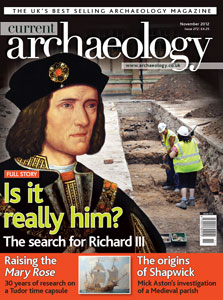Every school pupil knows Richard III’s apocryphal cry of ‘A horse, a horse, my kingdom for a horse’. But what happened next? This school pupil was taught that after being dragged through the streets of Leicester the slain king’s corpse was pitched into the River Soar. Not so, it seems. While the tradition that Richard III was denied burial has a long pedigree, various Tudor writers place his final resting place at Greyfriars in Leicester. Such sources are not unbiased. Hellbent on blackening Richard’s reputation, even if victor’s justice baulked at dumping Richard’s body in a river, it certainly ran his reputation through the gutter.
Either way it should be no more than an interesting historical footnote. Over half a millennium later Richard’s body was surely as untraceable as if it had been hurled into the Soar. After being demolished during the Dissolution, the friary disappeared beneath Leicester, to be truncated by later buildings and riddled with services. Even if Richard’s remains survived the Dissolution they were likely to have been obliterated by more recent development. At best he would be just another anonymous skeleton. This is what made the press conference held by the University of Leicester on 12th September so electrifying. As five reasons for interest in the skeleton of an adult male were read out, the similarities with the missing monarch became more and more tantalising, building to the revelation that a spinal condition made his right shoulder visibly higher than his left.
Is it him? We will not know for a few months yet, but if Richard has been found, it will be a stunning conclusion to an audacious piece of archaeological detective work.
FEATURES/n
RICHARD III/n
The search for the last Plantagenet king
Have University of Leicester archaeologists uncovered the final resting place of one of England’s most infamous monarchs?
SHAPWICK
/n
10,000 years of a Somerset parish
Mick Aston and Teresa Hall guide us through their research into the development of Medieval rural settlement.
MARY ROSE/n
Celebrating three decades of research
On the 30th anniversary of the famous wreck being raised, we look back on a flagship conservation project.
THE PAST FROM THE AIR/n
The origins of aerial photography
Exploring the high-flying pioneers of an essential archaeological resource.
/n
NEWS/n
Hallmarks of greatness; Unpicking Hollingbourne’s henge; A second sister for the Orkney Venus; Ardnamurchan update; Expanding Papcastle; Buying the boar; Falmouth’s pioneering vessel; Rounding up heritage crime.
REGULARS/n
Context
An aerial overview of the Bamburgh Research Project
Reviews
Monk Bridge Ironworks; The Archaeology of the South Downs National Park; Roman Nottinghamshire; Roman soldiers and the Roman army
Sherds
Chris Catling’s irreverent take on heritage issues.
Last Word
Andrew Selkirk talks about new ventures in crowd-sourced digging.
Odd Socs
The British Society of Master Glass Painters

